Menu
We have an extensive collection of fine quality, antique bookcases of different sizes and periods from small open bookshelves to large library bookcases.
Showing 1–16 of 66 results


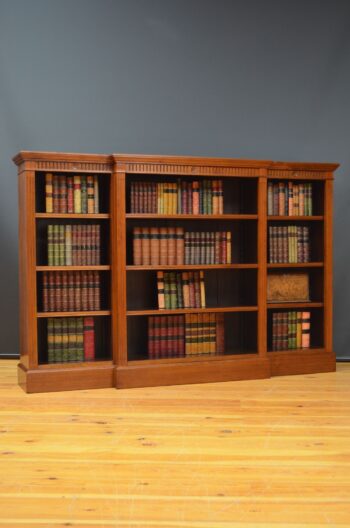
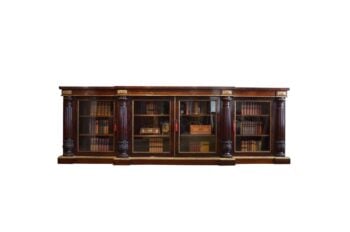
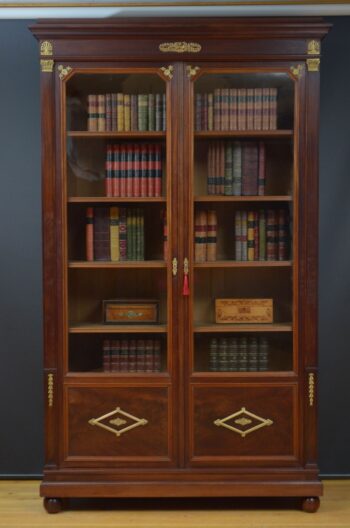
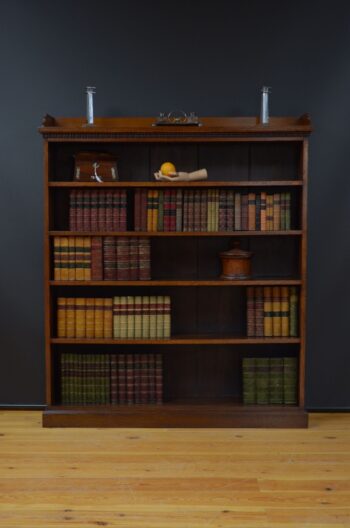
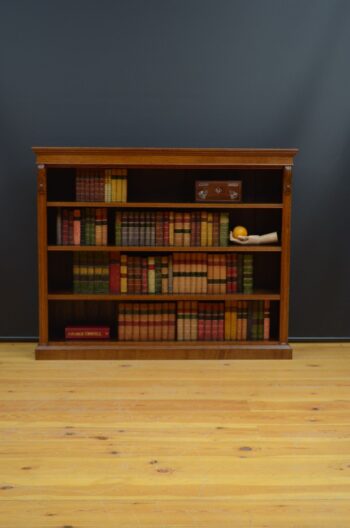
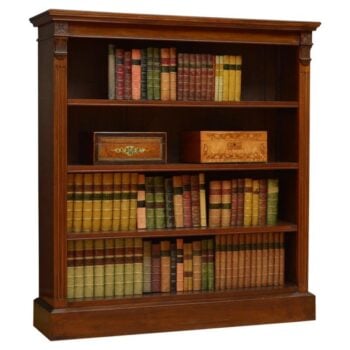
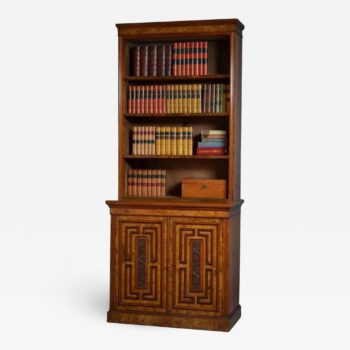
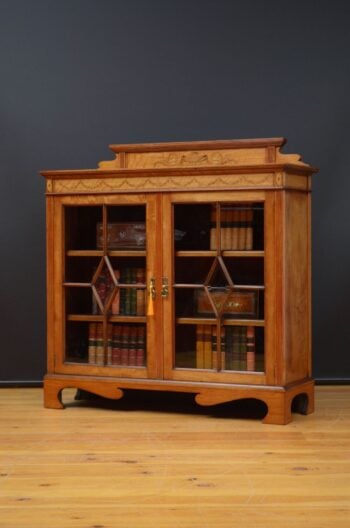
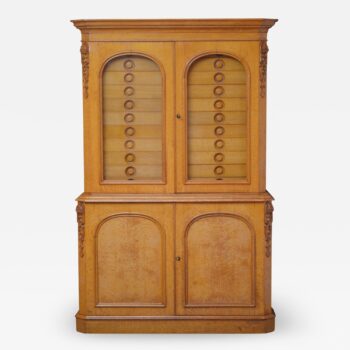


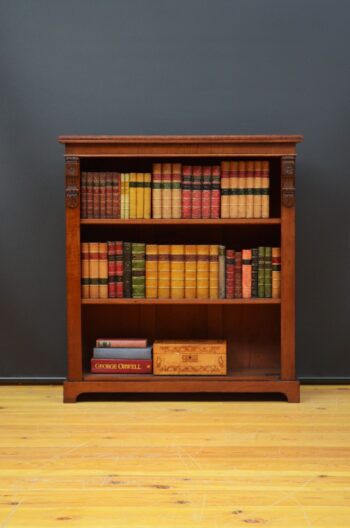
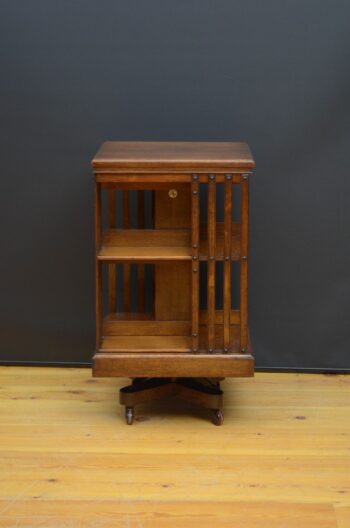
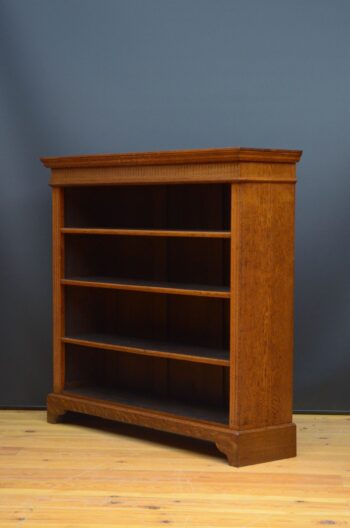
Perhaps unsurprisingly, the history of antique bookcases runs parallel with the histories of societal wealth, the costs of production, and the spread of the printed word.
While the use of the earliest bookcases dates back to Egypt circa the 4th Century BC, and further afield in 1st-Century Rome and Imperial China, the limitations of early reading technology (namely the expensive hand-scribed scroll) meant that bookcases needed to be built physically far deeper in order to store these precious scrolls safely – which involved more wood in their costly construction.
With widespread social illiteracy and the prohibitive cost of reading material creating little demand, these early bookcases would have been particularly expensive to build at scale – and hence limited to a society’s ruling class.
However, as affluence accelerated, wealthy Romans of the Late Republic were known to furnish their villas with grand private libraries – but again, it was the cost and inherent fragility of the scroll which dictated these shelves’ design, and their prohibitive expense.
Even in the 1st Century AD, Romans began to replace the scroll format with the bounded codex, a squared prototype of the modern book, intended to vastly reduce storage space. However, the time and cost of reproduction by hand would still prove to be a dominating factor in the bookcase’s limited societal use.
For the centuries that followed the fall of the Western Roman Empire, information among the general European populace was spread largely by word-of-mouth, or else dictated by the crown and clergy, through their exclusive access to costly illuminated vellum texts.
The sheer weight and luxurious worth of these manuscripts’ metal mountings, heavy protective covers and gilded decorations would have made them hefty precious objects, requiring sturdy storage more akin to an oak safe than a “modern” antique bookcase.
It wasn’t until the development of the Gutenberg printing press in the 15th century that more affordable books – and their falling associated costs, like paper (or rag) bleaching and manufacture – actually began to make literacy (and widespread public education) a more democratic prospect.
Even still, the modern antique bookcase is a relatively new innovation, since domestic bookcases largely remained the exclusive preserve of wealthy individuals’ home libraries until the early 18th century.
The renowned French cabinetmaker and pioneer of marquetry, Charles Andre Boulle, is widely thought to have originated the design of the first low, latticed bookcase design in the 17th century.
Buyers of the first tall bookcase designs, on the other hand, fittingly include the likes of Samuel Pepys – whose delivery of solid, bespoke, glazed oak bookcases in 1666 was prompted by his growing abundance of increasingly affordable books, paired with ever less living space to accommodate them. Suffice to say that demand for the bookcase caught on.
Among the first widely available bookcases during the Georgian era (1714-1837) were the designs of Thomas Chippendale, equally famous as a master craftsman of the Gothic and Rococo style, and as a master marketer of his ornate signature style.
As one of the many affordable results of now-widespread printing technology, Chippendale’s 1766 prototype catalogue publication, The Gentleman and Cabinetmaker’s Director, boasted over a dozen bookcase designs.
Georgian antique bookcases are generally characterised by a prevalence of mahogany, paired with advances in jointing, and evolving aesthetic tastes towards height, elegance and ornamentation – and the newly wealthy’s moves away from traditional, common and medievally-basic oak.
These days, Georgian antique bookcases can range well into tens of thousands of pounds. It’s testament to their solid yet increasingly innovative construction, and the considerable value of their provenance; the personal stories that these items can tell from the tumultuous Age of Enlightenment.
Antique bookcases of the Regency and Victorian era (1811-1901) are more defined by their variety, specific utility and ever-increasing availability, led by the dwindling cost of book manufacture and the growing popularity of literature – and also society’s increasing orders of furniture by catalogue purchase.
Out of the Agricultural and Industrial Revolutions came vastly expanded trade and travel routes, opening up an entire world’s worth of materials and design influences. Styles ranged from the dark super-ornate of Indian Victoriana in the East to the gloriously bright inlaid complexities of Turnbull’s Jamaican hardwoods in the West. The growing availability of imported woods like ebony, satinwood, sabicu and bird’s eye maple further differentiated the haves from the have-nots in Victorian society – so if one term could define the furniture of this era, economic diversity might best hit the mark.
Wealthy Victorians’ love of all things dramatic, imposing, neoclassical and elaborate reflected the proud industrial and artistic might of the British Empire, which can be seen represented in bookcase styles of the era – notably in opulent walnut, rosewood and amboyna, alongside traditional oak and mahogany.
Demand for bookcases was also increasingly shaped by a burgeoning middle-class, whose often rapid progress into wealth created a societal arms race of the grandest homes, filled with many rooms of highly specific function, and each with their own variety of appropriate bookcases to fill.
Alongside widespread artistic innovation following the Arts and Crafts movement, and ever-evolving technologies of production, the early 20th century was notable for its love of Georgian and Regency Revival reproductions – of which Revival antique bookcases played a starring role.
This movement, combined with ever-advancing industrial hardware and ever-decreasing publication costs (thanks largely to the rise of lithographic mass-printing in the late 19th century), truly democratised the ownership of books and finely crafted bookcases for the vast majority of society.
By the early 20th century, the majority of people in the UK were literate, they could afford mass-printed books relatively easily, and they had a wide choice of handmade or machined bookcases to keep them in. A far cry from literature’s early, and highly exclusive, ancient origins!
Although not to be confused with original Georgian items, Revival bookcases are still beautiful antique works of art and craftsmanship in their own right – and often available at a fraction of the cost of the original antique bookcases they pay tribute to. So, if you’d love to make your first forays into owning an original antique bookcase, a Revival piece can give you all the beauty and traditional craftsmanship of bygone eras, with a smaller investment to boot!
Since antiques are largely defined as items over a hundred years old. The Edwardian era and beyond really marks the end of this brief history of antique bookcases. So let’s now move into the whys and wherefores.
Given their age and good provenance, any great antique is already steeped in its own story – and what better place for your own favourite stories than an antique bookcase, with its own long decades of charm and character?
The truth is, people buy antique bookcases for many different reasons. Maybe you’d love a new home for your classical tomes, or a solid generational investment in an appreciating asset? Perhaps you’ve redecorated, or you’re making strides with more sustainable purchases? For many, antique bookcases are an antidote to flimsy mass-produced furniture; something with true personality. For others, it’s a vote for the craftsman, and traditions of human artistic excellence, over the cheap-and-samey or inescapably generic.
Others, meanwhile, invest in beautiful antique bookcases to put real heart and soul into a newly acquired property – or to put the perfect finishing touch on a period renovation.
Many antique dealers, like us here at Nimbus, choose certain antiques for their unique stories; and because we love those items ourselves. There’s very often a tale behind an antique bookshelf, where a reputable dealer can shed some light on its provenance and the nature of its craftsmanship.
Best of all, an antique bookcase embodies an ongoing story down the centuries that you have now become a part of, simply by taking that beautiful bookcase into your home.
If you’re new to the world of antique furniture, then we’d highly recommend a few little fact-finding adventures between as many dealers and fairs as you can. This will give you a richer, fuller idea of the styles and design movements that define the great British antique scene – it’s a treasure trove!
If, however, you’re ready to settle on a particular style for your antique bookcase, then a specialist antique dealer (like ourselves) would be the best way to find a fuller, more specific range all in one place – without the added pressure of buyer competition that tends to characterise antique events.
Instead, browsing an antique showroom at your leisure gives you all the time in the world to ask questions of a dedicated specialist in a particular field of antiques, and we’d always recommend that you ask plenty of questions before you buy!
Antique bookcases, well-stocked and cared for throughout the decades, amount to a personal distillation of knowledge, good taste and a love of the written word. And love is really the crux of it; since the best advice we can give you is only to buy an antique bookcase that you truly fall in love with!
| Cookie | Duration | Description |
|---|---|---|
| cookielawinfo-checbox-analytics | 11 months | This cookie is set by GDPR Cookie Consent plugin. The cookie is used to store the user consent for the cookies in the category "Analytics". |
| cookielawinfo-checbox-functional | 11 months | The cookie is set by GDPR cookie consent to record the user consent for the cookies in the category "Functional". |
| cookielawinfo-checbox-others | 11 months | This cookie is set by GDPR Cookie Consent plugin. The cookie is used to store the user consent for the cookies in the category "Other. |
| cookielawinfo-checkbox-necessary | 11 months | This cookie is set by GDPR Cookie Consent plugin. The cookies is used to store the user consent for the cookies in the category "Necessary". |
| cookielawinfo-checkbox-performance | 11 months | This cookie is set by GDPR Cookie Consent plugin. The cookie is used to store the user consent for the cookies in the category "Performance". |
| viewed_cookie_policy | 11 months | The cookie is set by the GDPR Cookie Consent plugin and is used to store whether or not user has consented to the use of cookies. It does not store any personal data. |